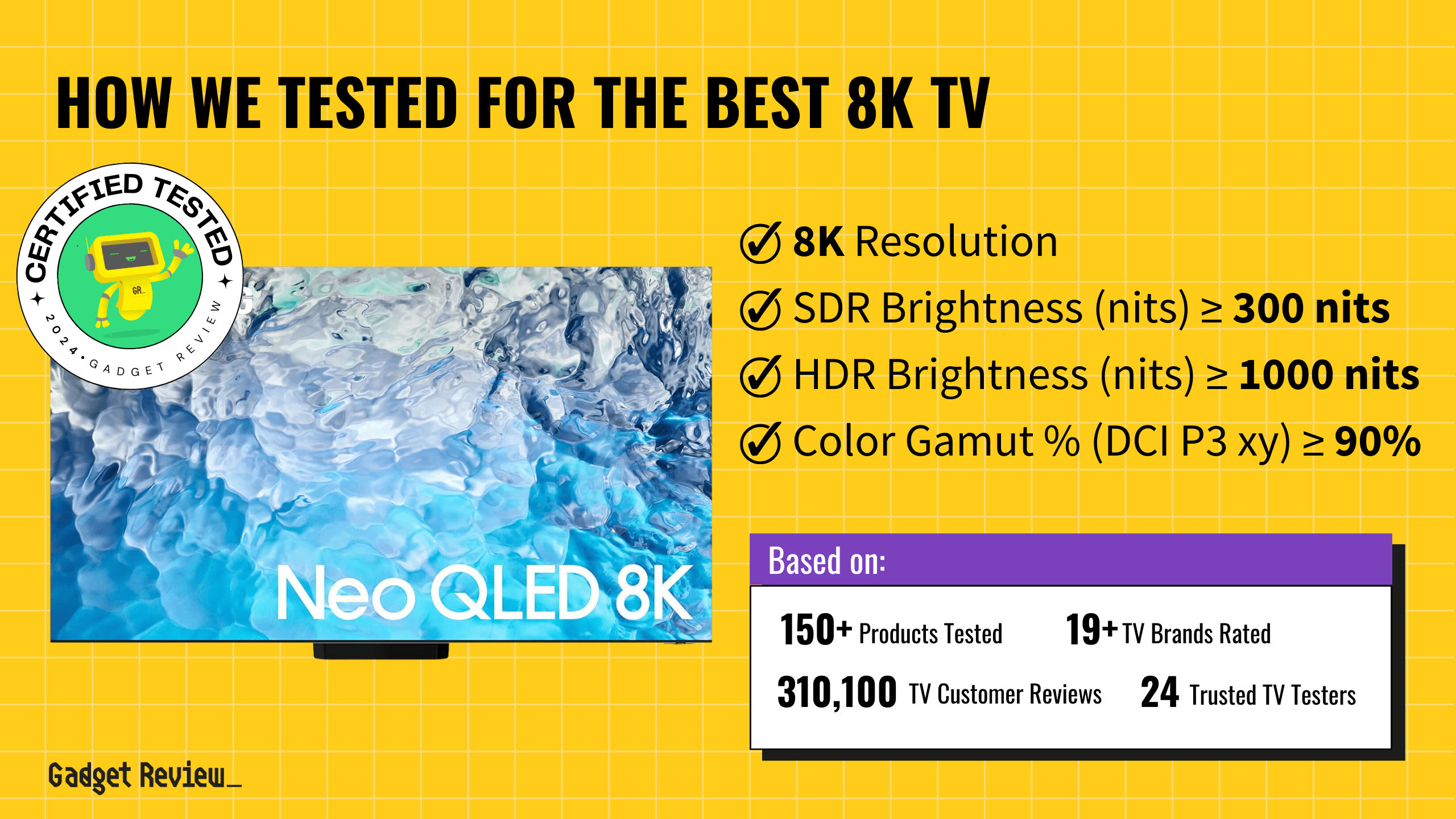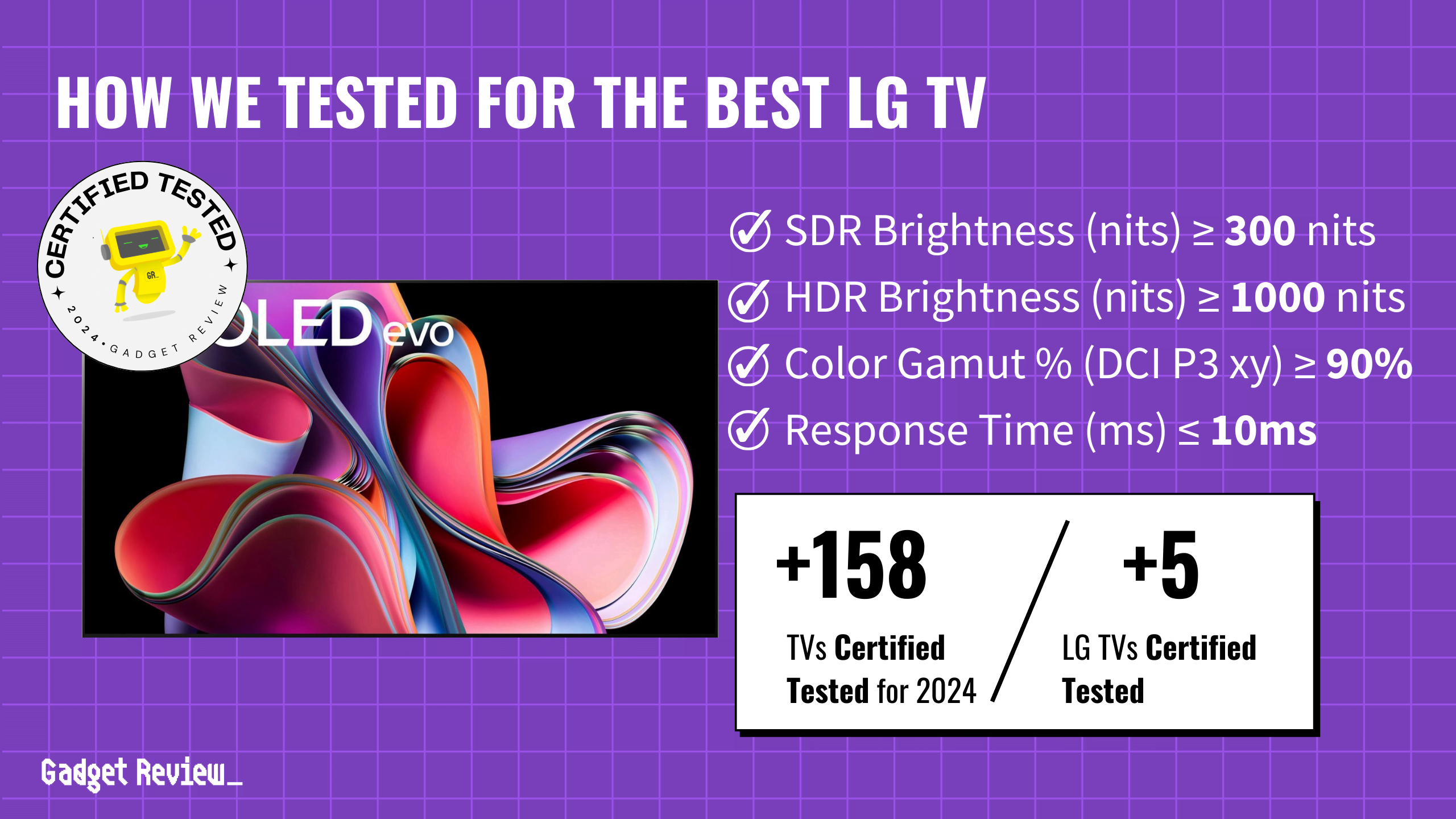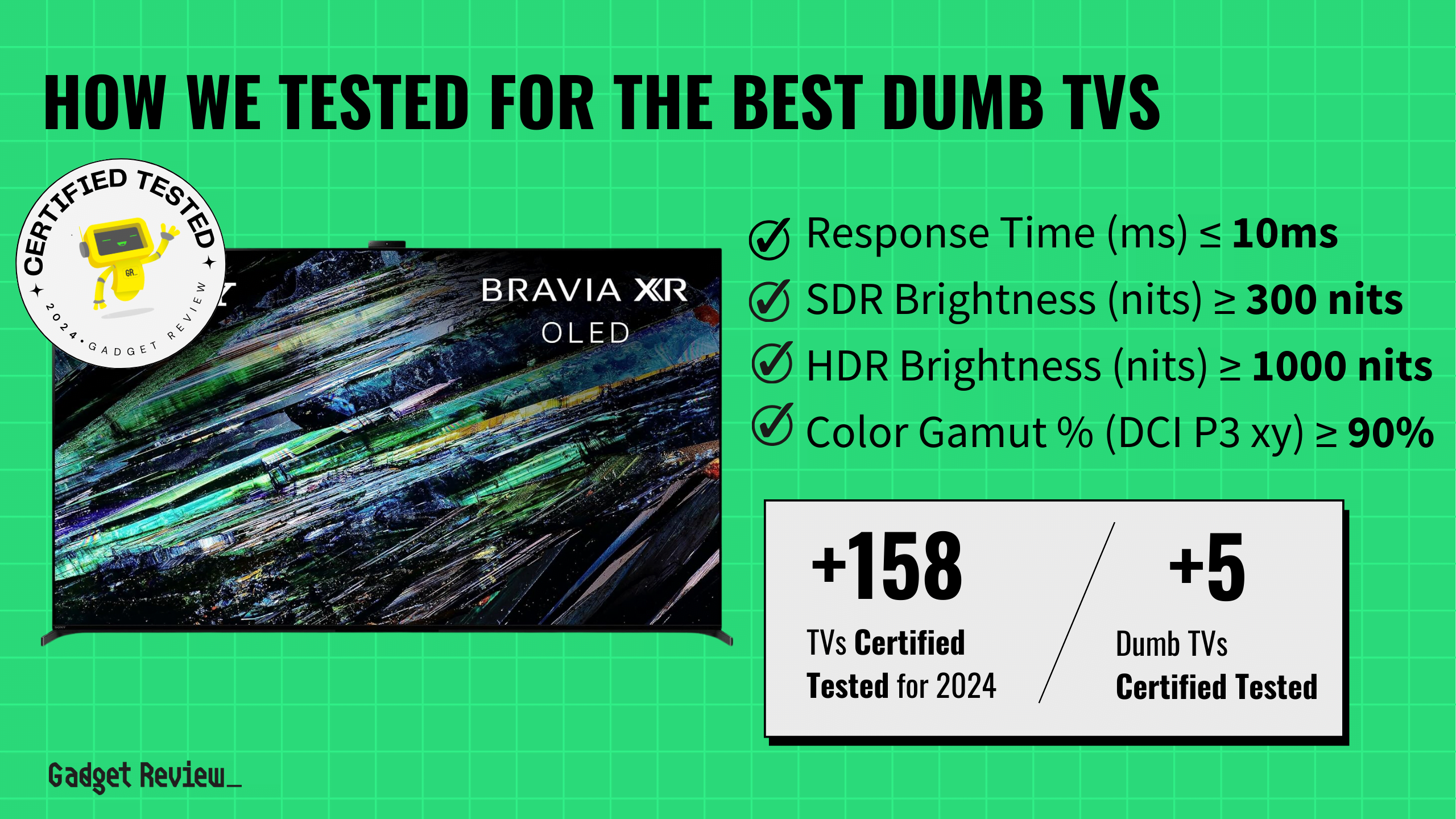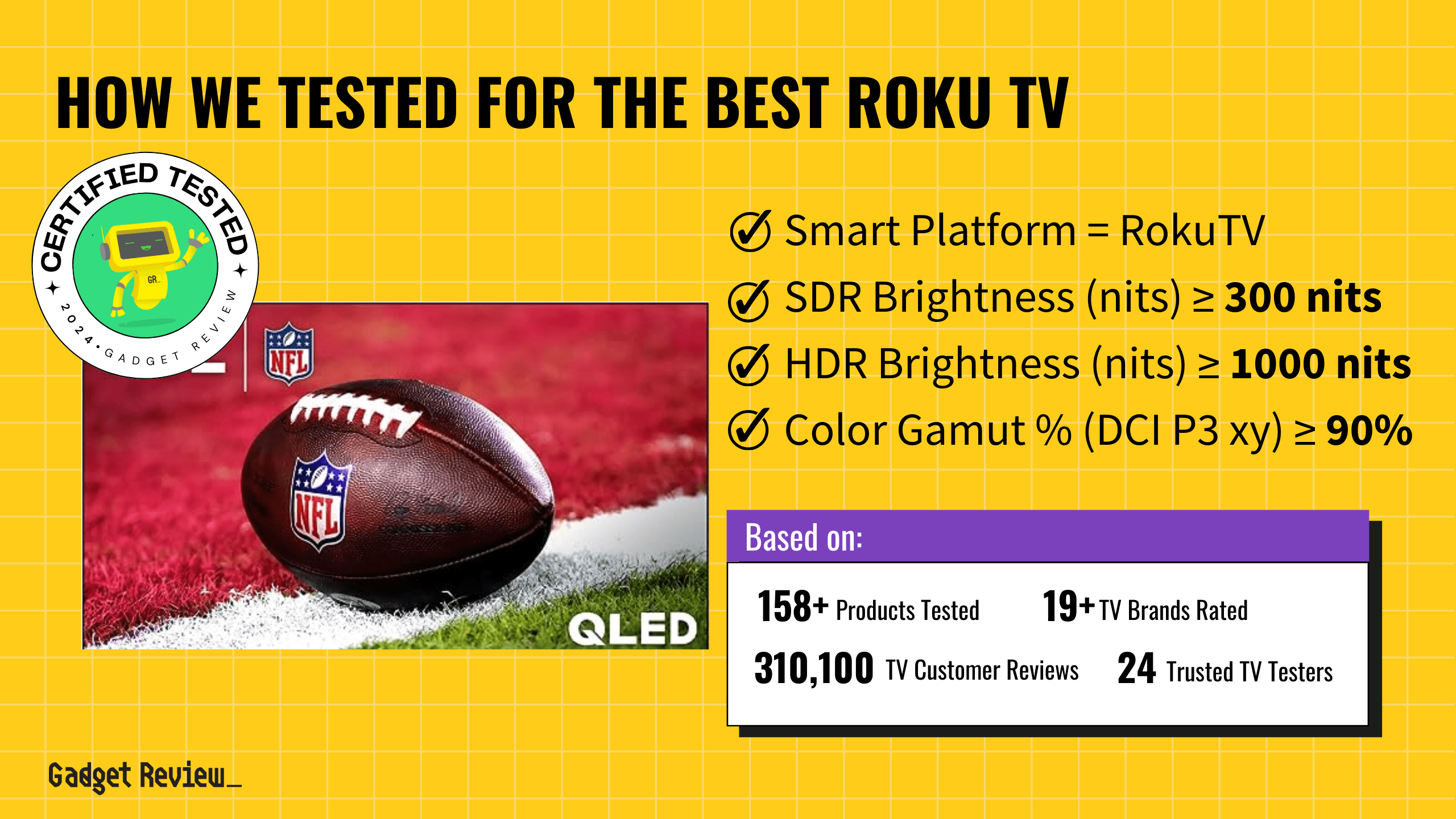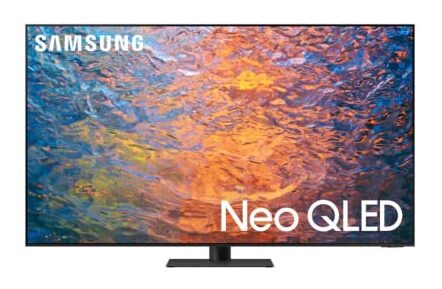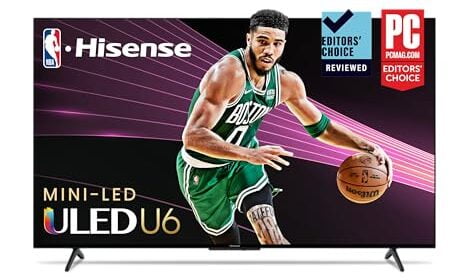Finding a TV with exceptional sound quality can be a challenge, especially with the common issue of flat screens often sacrificing audio for sleekness. However, you don’t have to settle for subpar sound. Our selection of the best sounding TVs is backed by comprehensive test data, ensuring you get immersive audio that complements the visual experience.
These models stand out not just for their sound but also for their picture quality and smart features, offering a well-rounded viewing experience. Whether you’re watching movies, streaming series, or playing games, our recommendations help you choose the best TV that delivers rich, clear audio without the need for external speakers or soundbars.


TL;DR
When you shop through our links, you’re backing our mission.
🎬 Choose the LG B3 if you value OLED quality at a lower cost, ideal for dim rooms.
📺 Opt for the Hisense U7K, excellent in audio clarity; great for immersive gaming.
🖥️ Grab the Hisense U8K for deep bass and minimal distortion, best for varied lighting.
How Did We Rank the Best Sounding TVs?
To assess how high or low quality a great sounding TV actually is, one must evaluate specific testing criteria against reference industry standards. Using our thorough TV Testing Methodology, we determined there are 2 minimum specs and 5 criteria below (2 required, 3 nice to have) that ensure your content sounds and looks as good as the creator intended it.
Minimum Specifications
- Speaker Output >= 20W
- Number of Audio Channels >= 2.1
Test Criteria
- Distortion Speaker [Weighted THD @80db] <= 0.100
- Low-Freq Extension (Hz) <= 60Hz
“Nice To Haves”
- SDR Brightness: Equal to or greater than 300 nits, ensuring a bright and clear display under any lighting conditions.
- HDR Brightness: 750 nits or more, to reveal the finest details in high dynamic range content.
- Color Accuracy: At least 90% of the DCI P3 color gamut, providing rich and vibrant colors.
We’ve redefined TV buying guides, setting us apart from any other site on the planet. Our unique approach combines in-house verification with a comprehensive dataset from over 200+ trusted sites, focusing on key testing metrics to rank the top-rated sounding TVs. Testing data and specs include SDR brightness of at least 300 nits, HDR brightness of 750 nits and above, and color accuracy with a minimum of 90% DCI P3 color gamut. We aggregate and analyze this data from 158+ TVs, ensuring our recommendations meet your specific needs. For the best sounding TV, this means delivering unparalleled resolution, exceptional brightness and color fidelity for an immersive viewing experience. Our commitment to unbiased reviews is powered by our ‘True Score’ system, targeting low quality and fake reviews. Commissions fund this mission. No bias. No BS.
Latest Updates
- 03/20/2024: Completely and thoroughly overhauled the guide to include the best and latest best sounding TVs.
- 11/30/2023: Republished the list to include TVs based on our True Score system.
Top Best Sounding TVs For 2025
Prices accurate at the time of publishing
To snag a spot on our list, a best sounding TV needs to have at least 20w speaker output and capable of battling glare from direct or indirect light. If it doesn’t hit these points, we’re not including it!

Best Overall

Runner Up

Best Value

Best Budget

Best Mid-Range

Premium Pick
LG B3 OLED TV
The LG B3 delivers OLED quality with excellent sound, vibrant colors, and true blacks at a lower price, though with slightly reduced brightness, making it ideal for dimmer settings.
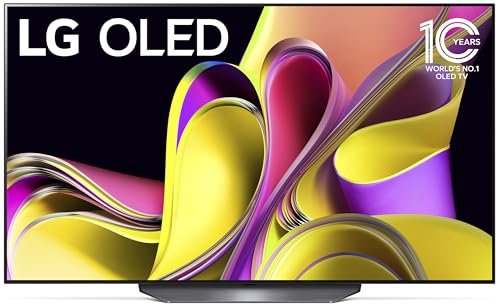
True Score
90884Experts
932kCustomers
Cosmic Wonder

Read More
Snapshot
Reasons to Buy
- Excellent picture quality
- Great Contrast
- High-performance motion handling
- Fast refresh rate
- Wide Viewing Angles
Reasons to Avoid
- Below Average Brightness
- Aggressive ABL
- Mediocre speaker sound quality
Specifications
Max Resolution 3840 x 2160 (4k) 
Backlight Type n/a Refresh Rate 120 Hz Display Type OLED HDMI Inputs 4 
HDMI Type HDMI 2.1 HDR Format Dolby Vision 
HomeKit Compatible Yes 
Number of Audio Channels 2.1 
Panel Type OLED Screen size 55", 65", 77" 
Smart Platform webOS 
Speaker Output 20 Watts 
Sync Technology AMD FreeSync Premium, G-Sync 
VRR Yes All Specs
Test Results
SDR Brightness (nits) 390 HDR Brightness (nits) 617 Color Gamut % (DCI P3 xy) 98.345 Response Time (ms) 3.1 Contrast Ratio (x:1) 0 EOTF (600 nit delta) 0.0067 Color Gamut % (DCI P3 uv) 99.62 Color Gamut % (Rec 2020 xy) 73.09 Color Gamut % (Rec 2020 uv) 77.66 Color Gamut % (sRGB) 0 Color Gamut % (Rec 709) 0 Color Gamut % (BT.2020) 73.14 Color Gamut % (Adobe RGB) 0 Color Gamut % (BT.709) 0 Input Lag (ms) 11.7 Color Washout (Degrees) 64 Color Shift (Degrees) 31 Brightness Loss (Degrees) 70 Reflections (%) 1.4 Low-Freq Extension (Hz) 84.76 Freq Response StdDev @ 70db 3.64 Freq Response StdDev @ 80db 3.67 Weighted Total Harmonic Distortion @80db 0.165 Intermodulation Distortion @80db 8.25 EOTF (1000 nit delta) 0.0035 EOTF (4000 nit delta) 0.0037 All Tests
All Retailers
- $1,149.00$2,400Save $1,251
Availability
In StockFree Shipping
No - $1,196.99$2,397Save $1
Availability
In StockFree Shipping
- $1,199.99$1,300Save $100
Availability
In StockFree Shipping
No Availability
Free Shipping
Our Verdict
The LG B3 offers up OLED picture quality and great sound in a less expensive package. It has a low-frequency extension of 84.76 Hz, giving it good bass performance, and weighted total harmonic distortion of just 0.17, guaranteeing that audio remains crisp and clear, even when the volume is ramped up.
With a color gamut of 98.35% in the DCI P3 xy color space, colors are exceptionally vibrant and lifelike. However, the B3’s SDR brightness levels peak at 390 nits, while HDR brightness stands at 617 nits, which means the B3 is less suited to bright rooms. If you’re setting up the TV in a dimmer home theater or game room, the B3’s reduced luminance will hardly be noticeable.
However, the low wattage of the B3 (20 Watts) means the maximum volume of the speakers won’t reach the same levels as other speakers on our list that pump more wattage through.
If OLED features and good value are at the top of your list alongside good audio performance, the LG B3 OLED TV is an easy pick. It offers a fine blend of sound clarity and visual vibrancy with excellent color accuracy, all for an entry-level OLED price.
Read Less

Best Overall

Runner Up

Best Value

Best Budget

Best Mid-Range

Premium Pick
Hisense U7K
A budget-friendly option, the Hisense U7K excels in sound and picture quality with impressive bass and vibrant colors, perfect for an immersive experience without extra audio equipment.
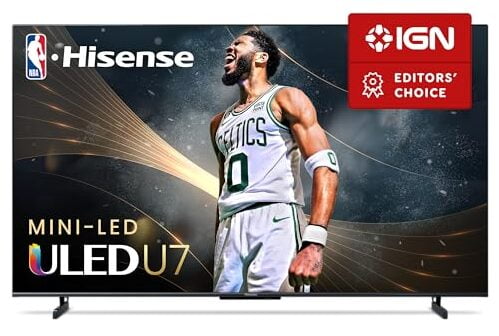
True Score
84859Experts
86777Customers
Absolutely Fresh

Read More
Snapshot
Reasons to Buy
- Outstanding picture quality in the dark
- High peak brightness
- Fast response time and low input lag
- 120 Hz refresh rate
Reasons to Avoid
- Subpar off-center viewing
- Average blooming
Specifications
Max Resolution 3840 x 2160 (4k) 
Backlight Type Full-Array Refresh Rate 120 Hz Display Type LED HDMI Inputs 4 
HDMI Type 2.0, HDMI 2.1 HDR Format Dolby Vision, HDR10, HDR10+, HLG 
HomeKit Compatible – 
Number of Audio Channels 2.1 
Panel Type IPS Screen size 55", 65", 75" 
Smart Platform Google TV 
Speaker Output 40 Watts 
Sync Technology HDR Format 
VRR Yes All Specs
Test Results
SDR Brightness (nits) 603 HDR Brightness (nits) 786.5 Color Gamut % (DCI P3 xy) 96.31 Response Time (ms) 11.3 Contrast Ratio (x:1) 45,000 EOTF (600 nit delta) 0.0211 Color Gamut % (DCI P3 uv) 97.4 Color Gamut % (Rec 2020 xy) 76.18 Color Gamut % (Rec 2020 uv) 81.91 Color Gamut % (sRGB) 98.5 Color Gamut % (Rec 709) 0 Color Gamut % (BT.2020) 76 Color Gamut % (Adobe RGB) 80.5 Color Gamut % (BT.709) 0 Input Lag (ms) 14.3 Color Washout (Degrees) 23 Color Shift (Degrees) 23 Brightness Loss (Degrees) 35 Reflections (%) 1.9 Low-Freq Extension (Hz) 89.8 Freq Response StdDev @ 70db 4.36 Freq Response StdDev @ 80db 4.48 Weighted Total Harmonic Distortion @80db 0.096 Intermodulation Distortion @80db 4.47 EOTF (1000 nit delta) 0.021 EOTF (4000 nit delta) 0.013 All Tests
All Retailers
- $759.99$800Save $40
Availability
In StockFree Shipping
No - $800.00
Availability
In StockFree Shipping
No - $1,008.32
Availability
In StockFree Shipping
No
Our Verdict
If you need a more entry-level television that is still capable of both good sound quality and picture quality, the Hisense U7K is definitely worth considering, especially if you want to avoid shelling out for a soundbar. Its low-frequency extension of 89.80 Hz means the U7K delivers respectable bass performance directly from its built-in speakers. The u7K also manages a best in class weighted total harmonic distortion at 80 dB of just 0.10. This means that even when you crank the audio, the TV maintains audio clarity and avoids distortion.
Visual performance is also a strong suit of the Hisense U7K TV. It features a color gamut of 96.31% in the DCI P3 xy color space, promising vibrant and true-to-life colors. With SDR brightness at 603 nits and HDR brightness reaching 786.5 nits, it ensures a good viewing experience across a variety of dim to moderately lit viewing conditions. With a contrast ratio of 45311:1, the TV can also put out good, deep blacks and bright whites, even if it still can’t quite compete with the U8K or OLED panels.
For anyone that needs a budget TV that won’t have you running to store for a soundbar and devices and excels in displaying vivid, engaging visuals, the Hisense U7K is a compelling choice. It balances great sound clarity with good visuals, and has enough bass response to help make movies and games feel that much more immersive, all at a very approachable price.
Read Less
DID YOU KNOW 87% OF TV REVIEWERS ARE UNTRUSTWORTHY?
Our research found 28 of 210 TV reviewers can be trusted, and shockingly 1 out of 3 on Google Page 1 were fake reviews showing no proof of test claims. See our Expose and Trust List. This is why Gadget Review is committed to calculating the most accurate product scores on the web.
To do this, we give every TV review site a Trust Rating, which measures how trustworthy the site and their testing claims are. We then leverage AI & a machine learning model to combine and calculate the Trust Rating with data from experts and consumers to deliver the True Score, the web’s most accurate product quality rating.

Best Overall

Runner Up

Best Value

Best Budget

Best Mid-Range

Premium Pick
Hisense U8K TV
Best For Home Theater
Offering top-notch sound and visual performance with exceptional brightness and color accuracy, the Hisense U8K is a standout choice for those avoiding OLED burn-in, at a great value.
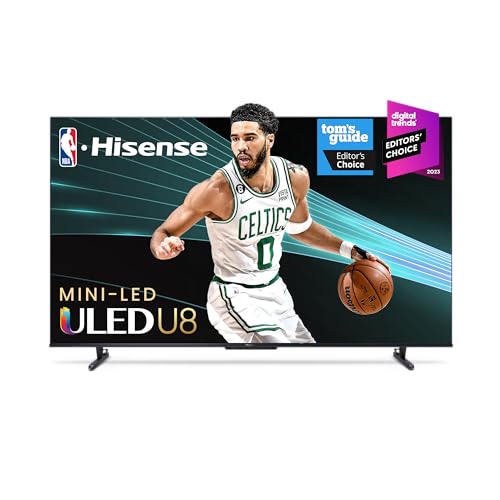
True Score
79796Experts
831kCustomers
Mixed Reviews

Read More
Snapshot
Reasons to Buy
- Good picture quality
- Outstanding brightness and good contrast ratio
- Quick response time
- Great reflection handling
Reasons to Avoid
- Poor viewing angles
Specifications
Max Resolution 3840 x 2160 (4k) 
Backlight Type Full-Array Refresh Rate 144 Hz 
Depth 3" Display Type LED HDMI Inputs (Total) 4 
HDMI Type HDMI 2.1 HDR Format Dolby Vision, HDR10, HDR10+, HLG 
Height 33.1" High Dynamic Range (HDR) Yes 
Number of Audio Channels 2.1.2 
Panel Type VA Screen size 100", 55", 65", 75", 85" 
Smart Platform Google TV 
Speaker Output 50 Watts 
Voice Assistant Google Assistant 
Weight 56.4" lbs 
Width 57.2" 
Works With Google Assistant All Specs
Test Results
SDR Brightness (nits) 1,549 HDR Brightness (nits) 1,792 Color Gamut % (DCI P3 xy) 97.44 Response Time (ms) 13.3 Contrast Ratio (x:1) 165,360 EOTF (600 nit delta) 0.0105 Color Gamut % (DCI P3 uv) 97.01 Color Gamut % (Rec 2020 xy) 76.18 Color Gamut % (Rec 2020 uv) 81.82 Color Gamut % (sRGB) 0 Color Gamut % (Rec 709) 0 Color Gamut % (BT.2020) 80 Color Gamut % (Adobe RGB) 0 Color Gamut % (BT.709) 0 Input Lag (ms) 14.2 Color Washout (Degrees) 23 Color Shift (Degrees) 23 Brightness Loss (Degrees) 35 Reflections (%) 1.8 Low-Freq Extension (Hz) 80 Freq Response StdDev @ 70db 2.06 Freq Response StdDev @ 80db 2.11 Weighted Total Harmonic Distortion @80db 0.1 Intermodulation Distortion @80db 0.71 EOTF (1000 nit delta) 0.0106 EOTF (4000 nit delta) 0.011 All Tests
All Retailers
- $849.99$1,000Save $150
Availability
In StockFree Shipping
No - $997.99
Availability
In StockFree Shipping
No - $1,450.40
Availability
In StockFree Shipping
No
Our Verdict
If a more budget TV that doesn’t have the risk of OLED burn-in is what you’re looking for in addition to good sound quality, the Hisense U8K TV can provide both good audio and visual performance. The U8K boasts a best-in-class low-frequency extension of 80 Hz, which makes it capable of putting out deeper bass than some of the more expensive options on the list. Plus, the audio fidelity of the Hisense U8K is more resistant to distortion, thanks to a weighted total harmonic distortion of just 0.10, the best in its class.
The U8K also features a strong color gamut of 97.44% in the DCI P3 xy color space, which is bolstered by excellent brightness that outpaces the OLEDs on our list. With an SDR brightness of 1549 nits and an even more impressive HDR brightness of 1792 nits, the U8K is a fantastic choice for both dark rooms and brightly lit environments. It doesn’t have the same contrast ratio as OLED – it’s impossible for it to, given its LED panel, but it still features an exceptional contrast ratio of over 165,000:1. This makes the U8K an outstanding choice for movie buffs that need a TV that can handle being in a home theater that is frequently very brightly lit.
If you’re searching for a television that offers robust audio performance out-of-the-box while also excelling in providing a very bright, immersive experience, the Hisense U8K is an excellent option. It adeptly combines sound clarity with visual brilliance, catering to a wide array of content from HDR movies to live sports, all without the necessity of external audio systems. Its remarkable brightness and color accuracy, plus the lack of any burn-in risk make the TV especially attractive, and it comes at a fantastic price.
Read Less

DON’T SEE WHAT YOU’RE LOOKING FOR?
If you are looking for the best smart TV, it’s essential to understand what a smart TV is, which includes internet connectivity and app support. Sometimes, issues like a black screen can occur, but these are generally fixable. For superior picture quality, many opt for the best 4K TV or even the best 8K TVs for unparalleled clarity, though the 4K vs 8K debate hinges on content availability and perceptible difference.
The best OLED TVs are praised for their deep blacks and vibrant colors, making them ideal for enthusiasts. For specific needs, such as the best TVs for seniors, features like ease of use and clear audio are prioritized. Additionally, the best TV monitors are designed for dual use, offering low input lag and high refresh rates for gaming and work.

Our Approach to Testing The Best Sounding TVs

Evan Shepard/Gadget Review
We’ve redefined TV buying guides, setting us apart from any other site on the planet. Our unique approach uses a comprehensive dataset from trusted sites, focusing on key testing metrics like brightness (SDR and HDR), EOTF, response time, contrast ratio and color gamut.
We aggregate and analyze this data, ensuring our recommendations meet the specific needs. Specifically, when it comes to the best sounding TVs, this involves selecting models that deliver not only optimal image quality for content but high-quality audio as well. Discover our data-driven methodology for precise, reliable TV recommendations.
You may notice some of our graphs contain “Source: RTings”. This is to indicate that the data we’re showing off in a graph has come from a single source – because it’s the only source that actually tested the criteria and had data for it! Normally, our data is an average out of all of the various publications that test and provide data to give you a good idea of how a product is going to perform on average.
Which Criteria Matters for Testing Best Sounding TVs?
By focusing on these criteria (3 required, 3 nice to have), anyone can quickly and easily compare these TVs and how they’ll perform. This helps you make an informed decision and purchase a TV that will fit into your small or tight space.
| CRITERIA | RANGE | REQUIRED | DEFINITION |
|---|---|---|---|
| SDR Brightness | 300+ nits | Yes | Assess the luminance of your display when operating in Standard Dynamic Range (SDR) mode. |
| HDR Brightness | 750+ nits | Yes | Determine the luminance of your display in High Dynamic Range (HDR) mode. |
| Color Gamut (DCI P3 xy) | >= 90% | Yes | Evaluate the extent to which a TV can reproduce a specified spectrum of colors. |
Our Trusted Data Sources
(Publication category Score is 80%+)
We looked at 210+ TV reviewers and while 24 are trustworthy (60%+ Trust Rating), we only use data from the testers that are “very trusted” which means a Trust Rating above 70%. The three we have listed below are our most trusted for TVs, along with our own in-house TV expert.
- Evan Shepard – Gadget Review
- Matthew Lopes – RTings, MuckRack
- Will Greenwald – PCMag, MuckRack, Twitter
- David Katzmaier – CNET, MuckRack, Twitter
Interested in a comprehensive analysis of our data sources? We’ve got you covered. Below, you’ll find a detailed list of every TV review website we’ve identified, organized by their respective Trust Ratings from highest to lowest. But we didn’t stop there. We’ve meticulously reviewed each publication and verified the data by checking whether the authors have bio links to MuckRack or LinkedIn. We’re committed to not only checking the facts but ensuring their veracity.
Best Sounding TVs Test Data & Results
1. SDR & HDR Brightness TV Test Results
In well-lit rooms, the brightness level of your best sounding TV, quantified in nits, is key to a great viewing experience. A TV that doesn’t meet the brightness requirement will struggle against natural and artificial light, resulting in a dim, lackluster image. Essentially, nits measure how well your TV can stand up to light interference, with higher values ensuring a sharper, more vivid display.
For standard viewing on the best sounding TV, you should look for at least 300 nits to strike the right balance between clarity and color quality in standard dynamic range (SDR) content. For high dynamic range (HDR) content, which offers richer colors and greater contrast, a minimum of 1000 nits is ideal to truly appreciate the enhanced visuals. These brightness levels are recommended to ensure your TV performs well in bright settings, allowing you to enjoy your shows and movies without any loss in detail or quality. Aim for these minimums: SDR Brightness >= 300 nits; HDR Brightness >= 750 nits for the optimal experience.
Discover the top sounding TVs, ranked from brightest to least.
Brightness
SDR: 300+ nits
HDR: 750+ nits
Acceptable range of performance
Definition: Maximum brightness in a specified pattern size window. Most commonly measured in a 10% or 100% white window.
Units of Measurement: nits (alternatively cd/m²)
Tools to Measure: TV, luminance meter
Why It’s Important:
Brightness helps counter ambient light so that details and colors don’t wash out and get lost.
SDR Brightness (in nits, higher is better)
HDR Brightness (in nits, higher is better)
2. Color Gamut (DCI P3 xy) TV Test Results
Color Gamut
>= 90%
Acceptable range of performance
Definition: The TV’s capability to display a spectrum of colors.
Units of Measurement: % (color space coverage in percent)
Tools to Measure: Colorimeter
Why It’s Important:
Inaccurate colors compromise the authenticity of the content.
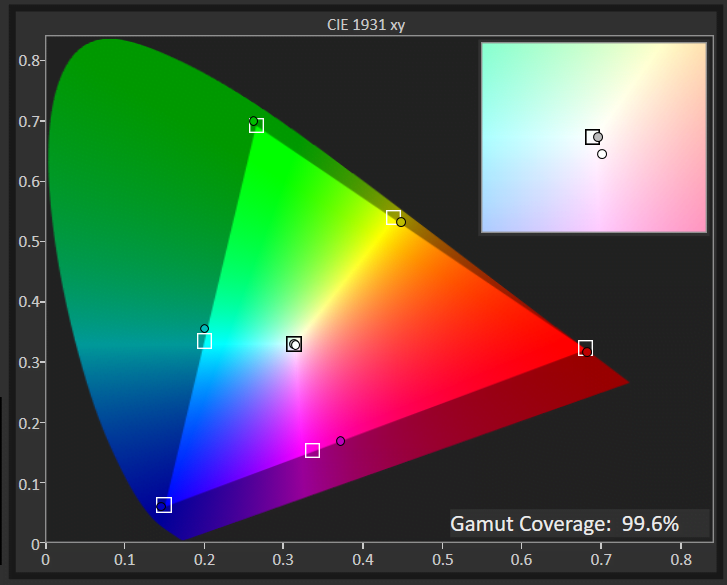
Color gamut defines the range of colors a best sounding TV can reproduce, directly affecting how vibrant and true-to-life the images look. A wide color gamut in a TV brings out richer, more vivid colors – from the lush greens of a garden to the bright colors of animated characters, enhancing your viewing experience to closely mimic real life.
This concept is technically measured against standards like the DCI P3 xy, a benchmark for high-quality visuals. A TV covering a higher percentage of this color space can display colors more accurately and vividly.
For those who prioritize vibrant and immersive visuals, aiming for a TV with a color gamut of 90% or higher on the DCI P3 xy scale is ideal. This ensures that the content you watch is as vibrant and lifelike as possible.
Below are the top sounding TVs, ordered by color gamut, all exceeding our testing criteria.
DCI P3 XY Color Gamut (as a %; high is better)
Best Sounding TVs: Mistakes To Avoid
- Ignoring Audio Quality: Many people focus solely on the visual aspects, such as the TV’s resolution and screen size, while neglecting audio quality. A TV may have a stunning picture, but if the sound is poor, it can significantly detract from the viewing experience. Look for TVs with high-quality built-in speakers or consider investing in a separate soundbar or home theater system. Learning how to connect a soundbar to your TV can be a game-changer, especially for models that support seamless Bluetooth or HDMI ARC connections. For those seeking an immersive audio experience without the clutter of wires, the best wireless surround sound systems offer an elegant solution, providing rich, room-filling sound that can make every movie night unforgettable.
- Overlooking Connectivity Options: Another common mistake is overlooking the connectivity options available on the TV. Make sure the TV has the necessary ports to connect external audio devices, such as soundbars or AV receivers. Additionally, consider whether the TV supports Bluetooth or Wi-Fi connectivity for wireless audio streaming from your smartphone or other devices. For gaming enthusiasts, consider the top gaming TVs, which have ample connectivity options, high refresh rates, and low input lag, providing a seamless and immersive gaming experience.
- Ignoring Room Acoustics: The acoustics of the room where the TV will be placed can significantly impact sound quality. Large, open spaces with hard surfaces can create echoes and reverberations that degrade sound quality. Consider the layout and furnishings of the room, and if necessary, use acoustic treatments like rugs, curtains, or wall panels to improve sound quality. You should also consider the lighting in the room.
- Focusing Only on Brand Reputation: While brand reputation can be a helpful indicator of quality, it’s essential not to rely solely on it when choosing a TV. Different TV models from the same brand can vary significantly in terms of audio quality. Take the time to research and compare specific models, read reviews, and listen to the sound quality in person, if possible, before making a decision. When searching for the best TV for sports, consider factors like motion handling, refresh rate, and color accuracy, as these aspects can greatly enhance the viewing experience, especially for fast-paced action scenes. Some of the top TV brands offer models specifically designed with sports enthusiasts in mind, boasting features like smooth motion technology and vibrant color reproduction. Additionally, durability and weather resistance are paramount if you’re looking for a great Outdoor TV.
The Best Sounding TVs Tests Compared
Product |
True Score
|
SDR Brightness
|
HDR Brightness
|
Color Gamut
| |
|---|---|---|---|---|---|
| 90 |
|
|
| $1,149.00 $2,400 $1,251 |
| 84 |
|
|
| $759.99 $800 $40 |
| 79 |
|
|
| $849.99 $1,000 $150 |
















